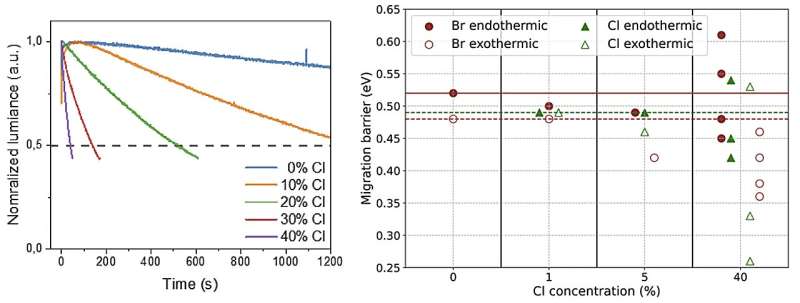This article has been reviewed according to Science X's editorial process and policies. Editors have highlighted the following attributes while ensuring the content's credibility:
fact-checked
proofread
Chloride ions kill the stability of blue perovskite light-emitting diodes: Study

Blue light-emitting diodes represent a fundamental element in the contemporary lighting and display technology landscape. Like prevailing technology such as III-V, organics and quantum dot LEDs, developing efficient and stable blue perovskite light-emitting diodes (PeLEDs) is a formidable challenge.
Over the past few years, the research community has experienced a remarkable upsurge in the external quantum yields of blue PeLEDs, bringing them closer to the level of more mature technologies. Nevertheless, these blue PeLEDs continue to grapple with a pronounced Achilles' heel—a disconcerting lack of operational stability. Even under relatively mild operating conditions, their half-lifetime extends from mere tens of seconds to just a few minutes. This issue has emerged as a pivotal obstacle to their future commercial viability.
A research team led by Prof. Weidong Xu at Northwestern Polytechnical University in China and Prof. Feng Gao at Linköping University in Sweden have found the reasons behind the short operational lifetime of blue PeLEDs.
The work titled "Role of chloride on the instability of blue emitting mixed-halide perovskites" was published in Frontiers of Optoelectronics.
Typically, mixed chloride/bromide perovskites are employed to produce ideal blue emission. However, the researchers have uncovered a counterintuitive fact: even minute quantities of chloride loading exert a dramatic negative impact on the operational lifetime of these devices. They also find that such an issue is an intrinsic problem that chloride ions are of a very low migration energy barrier in mixed bromide/ chloride perovskites, making them rapidly leave perovskite films under electrical bias.
These findings underscore the necessity for innovative strategies to immobilize chloride ions within blue perovskite emitters.
More information: Max Karlsson et al, Role of chloride on the instability of blue emitting mixed-halide perovskites, Frontiers of Optoelectronics (2023). DOI: 10.1007/s12200-023-00088-x
Provided by Higher Education Press



















